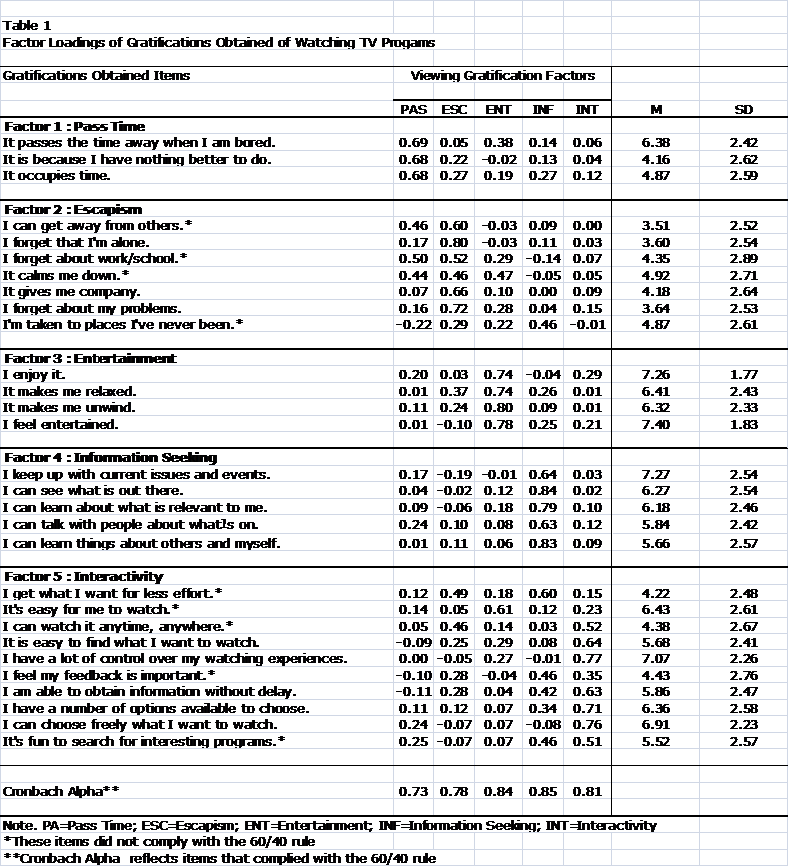Media Effects Research Lab - Research Archive
Media device effect
Student Researcher(s)
Jennifer Fyock (Ph.D Candidate);
Sharon Santus (Ph.D Candidate);
Yuan Sun (Masters Candidate);
Yong Tang (Ph.D Candidate);
Faculty Supervisor
INTRODUCTION
Today, more and more “couch potatoes” are becoming “Internet potatoes.” Many tech-savvy viewers even watch TV in a fancier way: on personal digital assistants (PDAs) and MP3 players. By employing the uses and gratifications theory, a large body of literature has explored how people may differ in their gratification level when using different media devices. No scholars, however, have investigated the change of TV viewers’ gratifications obtained from watching TV programs on different media devices. Furthermore, interactivity has never been used as a factor to measure gratification.
The purpose of this study is to explore whether watching television programs on a TV provides different types of gratifications (five gratification factors include past time, escapism, entertainment, information seeking and interactivity. See table 1, factor loadings of gratifications obtained of watching TV programs) than watching TV programs on a computer/Internet, PDA or MP3 player. The secondary purpose is to explore whether genre preference (drama, comedy, new, sports and sex video/pornography) for TV programs make a difference in the gratifications obtained.
RESEARCH QUESTION / HYPOTHESES
RQ1: For TV program viewers, controlling for age, gender and other demographic information, time spent on watching TV programs & Internet connectivity, what is the relationship between type of media device and level of gratifications obtained?
RQ2: For TV program viewers, controlling for age, gender and other demographic information, time spent on watching TV programs and Internet connectivity, what is the relationship between type of TV program genre and level of gratifications obtained?
METHOD
A questionnaire was loaded onto LimeSurvey, an open source survey application hosted on Penn State University’s Web server. An email message including a link to the web survey was sent out. This resulted in a snowballing effect of respondents. The survey took about ten minutes to complete. 114 participants completed the questionnaire. Then all the data was uploaded to Jump, a statistical software for expert data analysis.
RESULTS
The Computer/Internet was a significant predictor of pass time as a gratification obtained. A preference for watching TV programs on the TV was significant as negative predictor of escapism as a gratification obtained. A preference for watching TV programs on the Computer/Internet was a significant predictor of escapism as a gratification obtained. A preference for watching TV programs on a MP3 player was a significant predictor of escapism as a gratification obtained. Watching TV programs on the Computer/Internet was a predictor of interactivity as a gratification obtained.
People with low TV preference consistently scored higher than people with high TV preference across four out of the five gratification factors. People with high computer/Internet preference consistently scored higher than people with low computer/Internet preference across four out of the five gratification factors.

CONCLUSION
People who prefer watching comedy obtained more gratifications from interactivity. People who prefer watching news had more gratifications from information seeking. People with a preference for watching sex video/porn obtained more gratifications from information seeking. People who prefer watching TV on MP3 players obtained more gratifications from escapism. People who prefer to watch TV on the Internet obtained more gratifications from pastime. People preferring watching TV on the Internet had higher gratifications from interactivity. People with low TV preference received more pastime, escapism, information seeking and interactivity gratification. People with high computer/Internet preference received more pastime, escapism, information seeking and interactivity gratification as well.
For more details regarding the study contact
Dr. S. Shyam Sundar by e-mail at sss12@psu.edu or by telephone at (814) 865-2173

